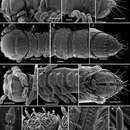en
names in breadcrumbs


Trichopolydesmidae is a family of millipedes belonging to the order Polydesmida.[1] This family includes two genera (Galliocookia and Occitanocookia) notable for featuring sexual dimorphism in segment number: adult females in these genera have the 20 segments (including the telson) usually found in this order, but adult males have only 19.[2] This family also includes the species Deharvengius bedosae, notable for being among the very few species in this order to feature adults with only 18 segments rather than the 20 segments usually found in polydesmids.[3]
This family includes the following genera:[1][4]
Trichopolydesmidae is a family of millipedes belonging to the order Polydesmida. This family includes two genera (Galliocookia and Occitanocookia) notable for featuring sexual dimorphism in segment number: adult females in these genera have the 20 segments (including the telson) usually found in this order, but adult males have only 19. This family also includes the species Deharvengius bedosae, notable for being among the very few species in this order to feature adults with only 18 segments rather than the 20 segments usually found in polydesmids.